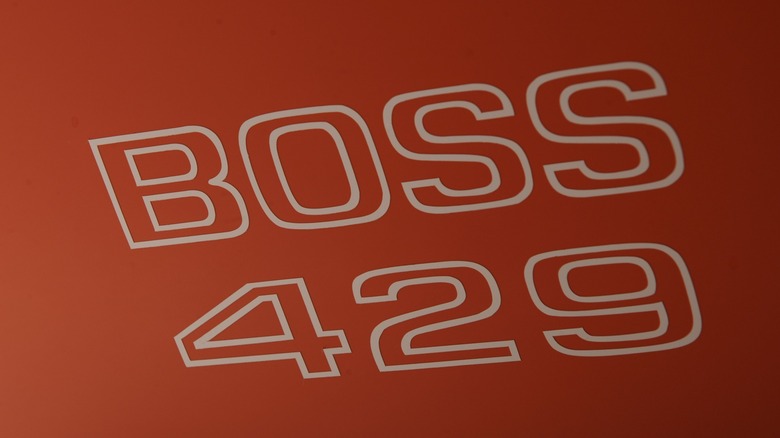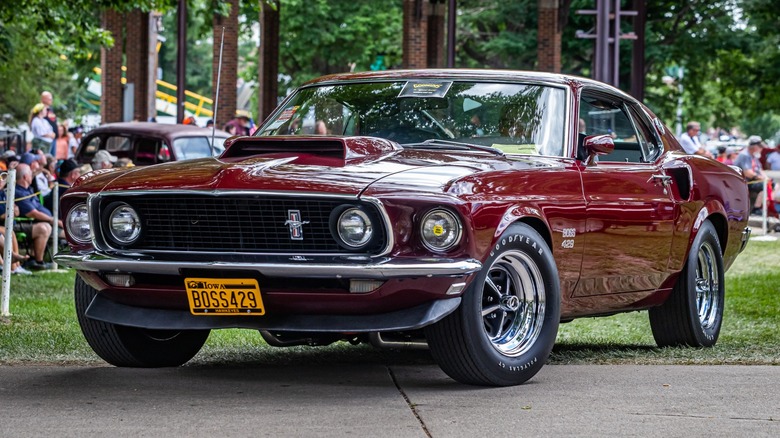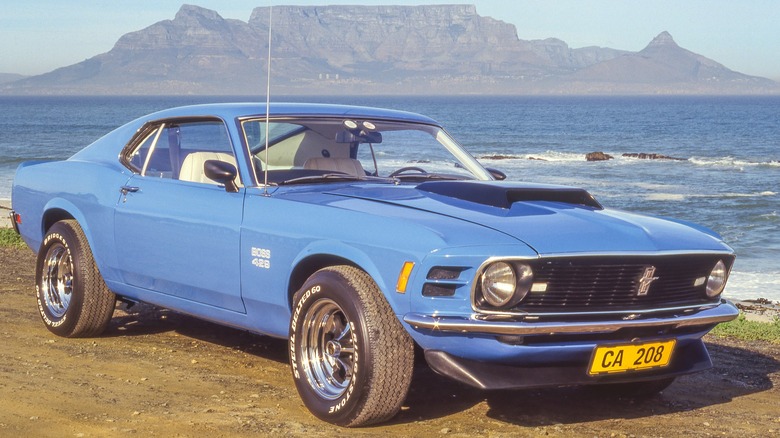Everything Ford Fans Should Know About The Mustang Boss 429
The well-documented characteristics of the mighty 429-cubic-inch powerplant lurking under the hood of the Mustang Boss 429 do not need another deep dive. A quick synopsis should suffice before further exploring the short two-year production run of the most potent Mustang from the muscle car era.
NASCAR's homologation rules required a limited production of at least 500 commercially available Boss 429 engines before race teams could use them for competition. The Boss 429 would have fit better in the larger production-model Torino, the car on which NASCAR teams based their Ford racecars. However, the Mustang was Ford's most popular sports car, so engineers modified the Mustang Boss 429 to receive the big block.
The 1969 Ford Mustang Boss 429, code-named Job 1, used a cast iron block with cylinders bored to 4.36 inches in diameter and a forged steel crankshaft with 3.59 inches of stroke. Its cast aluminum cylinder heads featured crescent-shaped combustion chambers that some dubbed the semi-hemi. The heads use intake valves measuring 2.275 inches in diameter and 1.895-inch exhaust valves. Ford combined those large valves with equally large intake and exhaust ports, allowing the Boss 429 to move massive amounts of air, fuel, and exhaust.
1969 Ford Mustang Boss 429
Ford created the Boss 429 to compete with Chrysler's 426 HEMI, but putting the gigantic engine into a Mustang engine bay provided unique challenges. Ford designated select Sports Roof (Fastback) 1969 Mustangs on the assembly line to receive the Boss 429 engine. As such, it would receive the Boss option package, which deleted the engine but added Boss 429 fender decals, a functional manually-operated hood scoop, a front spoiler, dual exterior mirrors, an engine oil cooler, trunk-located battery, power steering, power front disc brakes, close-ratio four-speed manual transmission, 3.91:1 limited-slip rear differential, ¾-inch rear sway bar, black deluxe interior, an 8,000-rpm tachometer, and AM/FM radio, according to Supercars. The 1969 Mustang Boss 429 offered a choice of five exterior colors: Raven Black, Wimbledon White, Royal Maroon, Candyapple Red, and Black Jade.
After the semi-completed 1969 Mustang Boss 429 chassis rolled off the line, it was shipped to Ford's racecar shop, Kar Kraft, for extensive modification. Kar Kraft fabricators cut and relocated the stock Mustang's front shock towers, various suspension parts, and the car's firewall to make room for the Boss 429. The modification required using a smaller brake booster, and air conditioning wasn't even offered as an option.
While winning races was the driving force behind the Boss 429 engine, it only received a 375 horsepower rating in the Mustang. For the big-bore engine to live up to its full potential, it needed airflow into the cylinders and out of the exhaust. Although expanded by Kar Kraft, the 1969 Mustang engine bay's small dimensions required a restrictive intake manifold and exhaust headers.
1970 Mustang Boss 429
Ford updated the Mustang for the 1970 model year, making subtle changes for the Boss 429 variant. While the 1970 Boss 429 used the same engine as the 1969 model, the two model years are easily distinguished. The front facia received the most dramatic change, morphing from four headlights in 1969 to two in 1970. Other exterior style changes include toning down the hood scoop and deleting the side vents aft of the door handles.
The choice of available factory exterior and interior colors also evolved. For 1970, Ford added a white interior option to the previous year's black and only offered Calypso Coral, Grabber Orange, Grabber Green, Grabber Blue, and Pastel Blue as exterior paint colors.
Reported numbers from the short two-year production run add up to around 1,358 Mustang Boss 429s, depending on who you believe. Regardless of the count being one or two cars off either way, the Boss 429 models only make up 0.3 percent of the Mustangs produced during those two years. To say intact specimens are rare 55 years after their introduction is an understatement.


